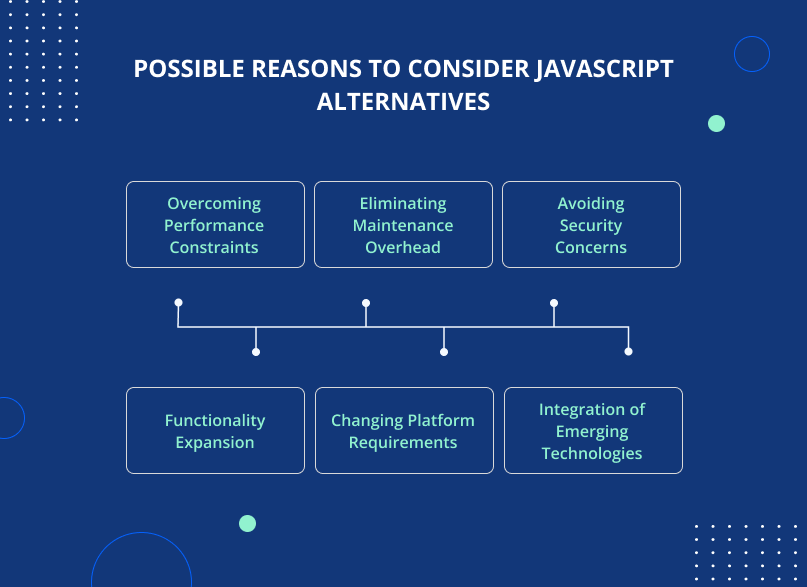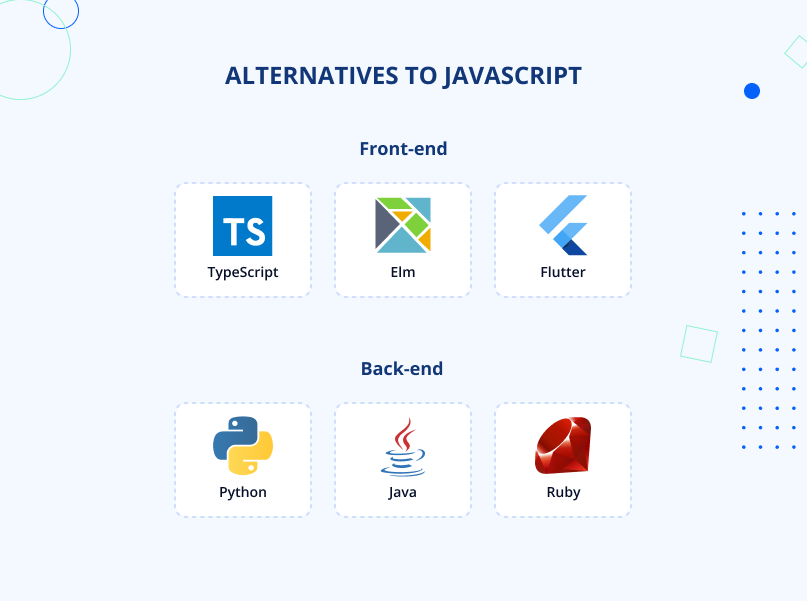Web development has been a crucial part of business prosperity for quite some time now. Whether it involves creating a website to establish an online presence or commercial web apps to engage users — the ultimate goal is revenue growth.
JavaScript has been the primary programming language that has served these objectives. It is used for creating interactive elements, dynamic content, and real-time updates on web pages. Its versatility, countless libraries, and frameworks, along with cross-browser compatibility, have made it a dominant web technology.
However, there are scenarios where seeking JavaScript alternatives becomes a strategic move to better align web development with business objectives. However, selecting the most suitable option can be quite a challenge.
To combat this issue, the following guide offers a business perspective on when and why to consider alternatives to JavaScript. Here, we will introduce six promising technologies that we believe can provide specific benefits over JavaScript.
Reasons to Consider JavaScript Alternatives
Before committing to alternatives, evaluating whether your project requires a departure from JavaScript is essential. This assessment can help you save two invaluable business resources — time and money.
Overcoming JavaScript Limitations
In the rush to deliver, businesses sometimes adopt technologies that fail to match their big-picture plans. This mismatch can trigger various problems, including poor app performance and maintenance challenges.
In the case of JavaScript, it could be a real-life scenario. Here are some JS limitations that can turn into critical issues as your web application grows:
- Performance Constraints: As applications become more intricate, JavaScript code and libraries may slow page loading times, thereby negatively impacting the user experience and driving visitors away.
- Maintenance Overhead: JavaScript dynamic typing can lead to subtle bugs that become harder to catch as your solution gets more complex. That can hinder the integration of new features, as developers will be involved in continuous error fixes.
- Security Concerns: JavaScript’s code is sensitive to security vulnerabilities such as cross-site scripting attacks. Preventing the issue often demands a lot of monitoring and careful coding practices. That’s why industries such as finance, banking, or healthcare may require alternative technologies with robust protection right out of the box.
If you’re constantly struggling with similar challenges or wish to avoid them in the future, exploring JavaScript alternatives might be the right step toward painless business growth.
Changing of Web App Concept
When the original vision of your solution undergoes significant changes, it’s better to reevaluate the technology stack to address new requirements. This can include cases like:
- Functionality Expansion: For instance, when enhancing a simple content-sharing platform with gaming or multimedia editing features, JavaScript alone might fall short. In this case, you’ll need something powerful to support the added complexity.
- Evolving Platform Requirements: If your application shifts from a web platform to multiple platforms (web, mobile, and desktop), adopting cross-platform technologies like Flutter would be a smart move. This approach will help to reuse a single codebase for chosen platforms.
- Integration of Emerging Technologies: For advanced capabilities like machine learning, a traditional JS stack may not be enough. In such cases, languages like Python can better accommodate this.
These are just a few examples when reassessing your JavaScript stack is recommended. Whatever your case may be, the goal is to choose proper JavaScript alternatives or complementary technologies to align with your company’s strategic plans.
Exploring Alternatives to JavaScript
JavaScript can also be used on the back end with the help of the Node.js runtime environment. This enables the creation of full-stack web solutions using JavaScript alone.
In the following sections, we delve into six compelling JavaScript alternatives for both frontend and backend development, offering potential solutions tailored to your project goals.
Alternatives to JavaScript for the Front End
TypeScript
TypeScript, which builds upon JavaScript, brings valuable features like static typing and interfaces. Its goal is to make a codebase more robust and organized, dealing with issues that often come up in JavaScript.
With static typing, TypeScript helps developers find bugs before running the code. This means they can fix errors before they become big issues, leading to improved app stability.
TypeScript encourages code organization into reusable modules and classes that can be modified separately. This enhances scalability, as developers can work on different parts of the application independently.
Finally, TypeScript is an easy transition for JavaScript developers. It offers learning a few extra tricks for better programming while still relying on JS basics.
Use cases for TypeScript:
- Large-scale applications
- Complex user interfaces
- Projects with multiple developers
Elm
Elm is a functional programming language primarily used for web applications. Elm offers a productive programming approach, and its core features help create robust and performant apps.
Elm often shows faster web page loading compared to JavaScript or its frameworks. This improves overall web app performance and leads to smoother user experiences.
Like TypeScript, Elm helps detect errors in the code before application runtime. This minimizes unexpected app behavior and ensures higher app reliability.
Elm relies on a functional programming paradigm with a focus on concise and reusable code. This can boost developer productivity and shorten development cycles.
Use cases for Elm:
- Gaming and interactive simulations
- Multimedia editing tools
- Real-time web apps
Flutter
Flutter is a cross-platform development framework built on the Dart programming language. It empowers businesses to create dynamic and high-performing applications, delivering cost-effective development.
A unified Flutter codebase caters to web, mobile, and desktop applications. As a result, businesses can reach broader audiences without developing multiple solutions.
Flutter also provides a range of pre-designed UI components for immediate use or
customization, saving time on development from scratch. Additionally, it allows engineers to make UI changes without reloading the entire app. These features facilitate rapid prototyping and ensure faster time-to-market.
Use cases for Flutter:
- Cross-platform applications
- Seamless UI across platforms
- Minimum Viable Product creation
Alternatives to JavaScript for the Back End
Python
Python, known for its concise syntax, thrives in backend development. It offers web frameworks like Django and Flask that streamline backend programming tasks.
One of the significant Python benefits is its syntax readability. This aspect helps engineers to make changes and fixes to the code faster, even as applications grow.
Python also places a strong emphasis on security. Thus, the Django web framework offers in-built security features to prevent common threats, reducing manual configurations.
Notably, Python is the primary language for incorporating emerging technologies. It provides numerous libraries specifically tailored to Machine Learning, Artificial Intelligence, and Data Science.
Use cases for Python:
- Web applications
- Data analysis and visualization
- ML and AI solutions
Java
Java, a veteran in the programming world, remains a strong choice for backend development. Renowned for its reliability and scalability, Java powers many enterprise-level solutions.
Unlike Node.js, Java provides robust built-in security mechanisms. They help to protect apps against viruses and attacks, making them an optimal choice for sensitive data applications (e.g., financial solutions).
While Node.js works well for real-time applications (e.g. streaming platforms), Java easily handles complex backend logic and large amounts of data, typical for enterprise-grade solutions.
Finally, using Java, engineers can effectively manage growing application workloads and user numbers without sacrificing performance.
Use cases for Java:
- Enterprise applications
- Financial, Banking, and Governmental systems
- E-commerce platforms
Ruby
Ruby, noted for a developer-friendly syntax, offers a highly flexible approach to backend development.
The Ruby on Rails web framework makes programming faster by providing the convention over configuration (CoC) and not repeating yourself (DRY) principles. The principles help automate repetitive tasks and minimize custom configurations, enabling faster development than Node.js.
Ruby’s focus on productivity makes it a good choice for rapid innovation, quick product changes, and testing hypotheses.
Use cases for Ruby:
- Small or medium-sized web applications
- Quick prototyping and MVP development
Each of the discussed JavaScript alternatives offers particular advantages that you should sync with your long-term goals. To support you in decision-making, we’ve prepared a comparison table that also includes ease of migration to a chosen technology and simplicity of hiring developers:
Note: The ease of migration to JavaScript alternatives also depends on factors like the complexity of the existing codebase and the familiarity of the development team with the new technology.
Are You Sure You Need JavaScript Alternatives?
Migration to JavaScript alternatives should be approached thoughtfully, as it can complicate your business strategy by extending project timelines or urgent recruitment needs.
In this sense, before embarking on a migration journey, assessing whether your challenges are rooted in technical expertise or communication gaps within your development team is crucial. For example, if the JS developer is unfamiliar with speed optimization practices, and the PM never outlined performance in project requirements — you’ll hardly receive a fast-loading website.
If the expertise or communication gap is indeed the issue, considering a staff augmentation company could be a better strategic choice. This may help to enrich the IT team with experienced specialists while saving your software projects from unnecessary shifts.
Summing Up
If your business is hindered by a shortage of skilled engineers, JayDevs is here to assist. We specialize in helping businesses connect with the right talent. Whether you need remote JavaScript developers or experts in other areas, our team of seasoned engineers, comprising Senior and Lead specialists, are ready to step in.
Simply contact us with a brief project description and the specialists you require, and we’ll get back to you with the relevant CVs.













